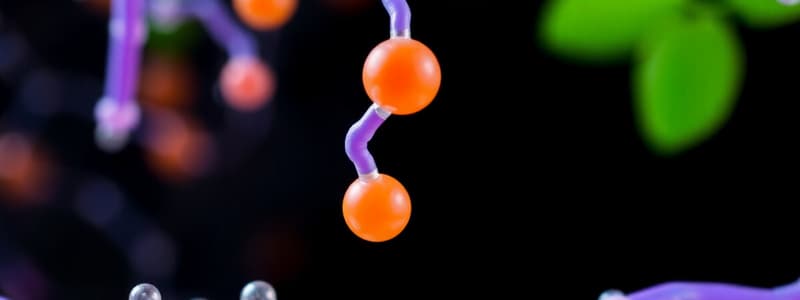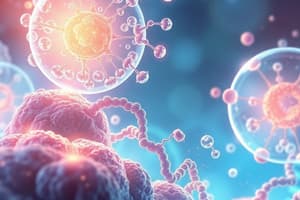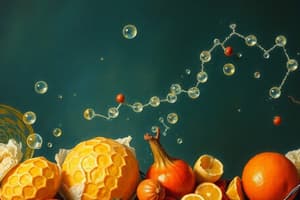Podcast
Questions and Answers
Which of the following polysaccharides is a branched polymer of glucose molecules?
Which of the following polysaccharides is a branched polymer of glucose molecules?
- Starch
- Hyaluronic acid
- Cellulose
- Glycogen (correct)
What is the main structural difference between starch and glycogen?
What is the main structural difference between starch and glycogen?
- Starch is a linear polymer, while glycogen is branched (correct)
- Starch is a heteropolysaccharide, while glycogen is a homopolysaccharide
- Starch is found in plants, while glycogen is found in animals
- Starch is made up of only glucose units, while glycogen contains other monosaccharides
Which of the following is a heteropolysaccharide?
Which of the following is a heteropolysaccharide?
- Cellulose
- Glycogen
- Starch
- Hyaluronic acid (correct)
Which of the following is NOT a function of polysaccharides?
Which of the following is NOT a function of polysaccharides?
What is the primary function of cellulose in plants?
What is the primary function of cellulose in plants?
What is the main function of gluconeogenesis?
What is the main function of gluconeogenesis?
Which of the following enzymes in glycolysis is inhibited by ATP?
Which of the following enzymes in glycolysis is inhibited by ATP?
During the preparatory phase of glycolysis, how many ATP molecules are consumed?
During the preparatory phase of glycolysis, how many ATP molecules are consumed?
Which condition promotes gluconeogenesis?
Which condition promotes gluconeogenesis?
What is produced during glycolysis from one molecule of glucose?
What is produced during glycolysis from one molecule of glucose?
Which of the following best defines carbohydrates?
Which of the following best defines carbohydrates?
What class of carbohydrates consists of 2 to 10 monosaccharide units?
What class of carbohydrates consists of 2 to 10 monosaccharide units?
Which type of sugar is a hexose monosaccharide?
Which type of sugar is a hexose monosaccharide?
What distinguishes aldoses from ketoses in monosaccharides?
What distinguishes aldoses from ketoses in monosaccharides?
What is the main characteristic of homopolysaccharides?
What is the main characteristic of homopolysaccharides?
Which of the following represents an oligosaccharide?
Which of the following represents an oligosaccharide?
Which statement is true regarding the structure of carbohydrates?
Which statement is true regarding the structure of carbohydrates?
Which of the following is not a function of carbohydrates?
Which of the following is not a function of carbohydrates?
Which statement correctly describes the Cori cycle?
Which statement correctly describes the Cori cycle?
What is required for gluconeogenesis to form one molecule of glucose from pyruvate?
What is required for gluconeogenesis to form one molecule of glucose from pyruvate?
What is glycogen primarily used for in skeletal muscle?
What is glycogen primarily used for in skeletal muscle?
Which hormones initiate glycogen breakdown in the liver?
Which hormones initiate glycogen breakdown in the liver?
During fasting states, which metabolic process occurs?
During fasting states, which metabolic process occurs?
Which reaction is bypassed in gluconeogenesis compared to glycolysis?
Which reaction is bypassed in gluconeogenesis compared to glycolysis?
What activates glycogenesis after a meal?
What activates glycogenesis after a meal?
What is the main structural characteristic of glycogen?
What is the main structural characteristic of glycogen?
Flashcards
Polysaccharides
Polysaccharides
Carbohydrates formed by long chains of monosaccharides.
Homopolysaccharides
Homopolysaccharides
Polysaccharides made up of one type of monosaccharide.
Heteropolysaccharides
Heteropolysaccharides
Polysaccharides containing more than one type of monosaccharide.
Starch
Starch
Signup and view all the flashcards
Glycogen
Glycogen
Signup and view all the flashcards
Carbohydrates
Carbohydrates
Signup and view all the flashcards
Monosaccharides
Monosaccharides
Signup and view all the flashcards
Oligosaccharides
Oligosaccharides
Signup and view all the flashcards
Disaccharides
Disaccharides
Signup and view all the flashcards
Aldoses
Aldoses
Signup and view all the flashcards
Ketoses
Ketoses
Signup and view all the flashcards
Glycosidic bonds
Glycosidic bonds
Signup and view all the flashcards
Cori Cycle
Cori Cycle
Signup and view all the flashcards
Gluconeogenesis
Gluconeogenesis
Signup and view all the flashcards
Irreversible reactions in Glycolysis
Irreversible reactions in Glycolysis
Signup and view all the flashcards
ATP requirement for Gluconeogenesis
ATP requirement for Gluconeogenesis
Signup and view all the flashcards
Glycogenolysis
Glycogenolysis
Signup and view all the flashcards
Glycogenesis
Glycogenesis
Signup and view all the flashcards
Metabolism Regulation States
Metabolism Regulation States
Signup and view all the flashcards
Glycolysis
Glycolysis
Signup and view all the flashcards
ATP production in Glycolysis
ATP production in Glycolysis
Signup and view all the flashcards
Key enzymes in Glycolysis
Key enzymes in Glycolysis
Signup and view all the flashcards
Function of Gluconeogenesis
Function of Gluconeogenesis
Signup and view all the flashcards
Study Notes
Carbohydrate Metabolism
- Carbohydrates are hydrosoluble molecules with the empirical formula (CH₂O)ₙ. Monosaccharides are the building blocks of larger carbohydrates.
- Carbohydrates serve various functions, including energy storage, structural roles (like cellulose in plant cell walls), and as components of other molecules (like glycoproteins and DNA).
Carbohydrate Classification
- Monosaccharides: Simple sugars, classified based on the carbonyl group (aldehyde or ketone).
- Aldoses have an aldehyde group.
- Ketoses have a ketone group.
- Examples include trioses (3 carbons), tetroses (4 carbons), pentoses (5 carbons), and hexoses (6 carbons) like glucose, fructose, and galactose.
- Oligosaccharides: Chains of 2-10 monosaccharides linked by glycosidic bonds.
- Disaccharides, like lactose (galactose + glucose), sucrose (glucose + fructose), and maltose (glucose + glucose), are examples of oligosaccharides.
- Polysaccharides: Chains of more than 10 monosaccharides.
- Homopolysaccharides are composed of a single type of monosaccharide unit, such as starch (glucose polymer in plants) and glycogen (branched glucose polymer in animals). Cellulose (unbranched glucose polymer in plants) is another example of a storage form.
- Heteropolysaccharides are composed of multiple types of monosaccharide units. An example is hyaluronic acid which is found in the synovial fluid and vitreous humor of the eye.
Digestion of Carbohydrates
- Polysaccharides and oligosaccharides are broken down into monosaccharides by enzymes in the digestive tract.
- Specific enzymes, like amylase (breaks down 1-4 bonds), lactase, and sucrase, target different bonds.
- The resulting monosaccharides are absorbed into the bloodstream.
Glucose Homeostasis
- Maintaining stable blood glucose levels (homeostasis) is crucial for energy provision to the brain and other tissues.
- After a meal, insulin is released, promoting glucose uptake by tissues and glycogen synthesis.
- During fasting or exercise, glucagon is released, leading to glycogen breakdown and gluconeogenesis (new glucose production).
Glycolysis
- The universal central pathway of glucose catabolism (breaking down).
- Glycolysis converts one molecule of glucose into two molecules of pyruvate in the cytoplasm.
- During glycolysis, some free energy released from glucose is conserved in the form of ATP and NADH.
- The pathway is regulated by key enzymes like hexokinase, phosphofructokinase, and pyruvate kinase.
Gluconeogenesis
- The pathway for synthesizing glucose from non-carbohydrate precursors, like lactate, glycerol, and some amino acids.
- Different enzymes in gluconeogenesis bypass irreversible steps in glycolysis.
- Gluconeogenesis is crucial for maintaining blood glucose levels during fasting.
Cori Cycle
- A cyclical process between muscles and the liver.
- During intense exercise, lactate (product of anaerobic glycolysis) in the muscles is transported to the liver.
- The liver converts lactate back to glucose via gluconeogenesis and then delivers the glucose back to the muscles, maintaining glycogen stores.
Glycogen Metabolism
- Glycogenesis: The synthesis of glycogen from glucose. Insulin stimulates this pathway.
- Glycogenolysis: The breakdown of glycogen into glucose. Epinephrine and glucagon stimulate this pathway.
- Glycogen serves as a storage form of glucose in animals, especially in the liver and muscles.
- Glycogen in muscle is for immediate energy use during contraction.
- Glycogen in the liver maintains blood glucose levels between meals and during fasting.
Regulation of Carbohydrate Metabolism
- Well-fed state: Insulin promotes glycogen synthesis and glucose uptake, and glycolysis.
- Fasting state: Glucagon promotes glycogenolysis and gluconeogenesis, while low blood glucose stimulates hormonal secretions for glucose production.
- Exercise: Epinephrine promotes glycogen breakdown and glycolysis in muscle and liver.
Studying That Suits You
Use AI to generate personalized quizzes and flashcards to suit your learning preferences.




